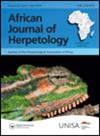Genetic diversity and differentiation of the Western Leopard Toad (Sclerophrys pantherina) based on mitochondrial and microsatellite markers
IF 0.9
4区 生物学
Q3 ZOOLOGY
引用次数: 4
Abstract
Abstract Intraspecific genetic diversity provides the basis for evolutionary change and is therefore considered the most fundamental level of biodiversity. Mitochondrial DNA (mtDNA) and microsatellite loci are the markers most typically used in population-level studies; however, their patterns of genetic variation are not always congruent. This can result in different interpretations of the data, which can impact on management decisions, especially for threatened species. Consequently, in this study, we developed and analysed novel microsatellite markers for the Endangered Western Leopard Toad (WLT), Sclerophrys pantherina, and compared the results to previously published mtDNA data to compare the level of genetic diversity between the two molecular markers. The microsatellite evidence showed signs of a past bottleneck, yet relatively high levels of genetic diversity and low genetic differentiation between two sampling sites. In contrast, the mtDNA revealed moderate to low levels of diversity between sampling sites, and strong genetic differentiation. An explanation for the conflicting patterns may be that the current genetic signature, as depicted by the microsatellite data, is not yet reflected in the mitochondrial dataset; and, as such the data are depicting a timeline for genetic variation within the WLT. Both markers revealed important information about the two sampling sites, which can help inform conservation management of the species.基于线粒体和微卫星标记的西豹蟾蜍遗传多样性和分化
摘要种内遗传多样性为进化变化提供了基础,因此被认为是生物多样性的最基本水平。线粒体DNA(mtDNA)和微卫星基因座是群体水平研究中最常用的标记;然而,它们的遗传变异模式并不总是一致的。这可能导致对数据的不同解释,从而影响管理决策,尤其是对受威胁物种。因此,在这项研究中,我们开发并分析了濒危西部豹蟾蜍(WLT)的新微卫星标记,即泛盘硬眼蟾蜍,并将结果与先前发表的mtDNA数据进行了比较,以比较两个分子标记之间的遗传多样性水平。微卫星证据显示出过去存在瓶颈的迹象,但两个采样点之间的遗传多样性水平相对较高,遗传分化程度较低。相比之下,mtDNA显示采样点之间的多样性水平中等至较低,遗传分化强烈。对冲突模式的解释可能是,微卫星数据所描述的当前遗传特征尚未反映在线粒体数据集中;因此,数据描绘了WLT内遗传变异的时间线。这两个标记都揭示了关于这两个采样点的重要信息,这有助于为该物种的保护管理提供信息。
本文章由计算机程序翻译,如有差异,请以英文原文为准。
求助全文
约1分钟内获得全文
求助全文
来源期刊

African Journal of Herpetology
ZOOLOGY-
CiteScore
3.00
自引率
6.70%
发文量
15
审稿时长
>12 weeks
期刊介绍:
African Journal of Herpetology (AJH) serves as an outlet for original research on the biology of African amphibians and reptiles. AJH is an interdisciplinary journal that publishes original articles and reviews from diverse fields and disciplines, such as conservation, phylogenetics, evolution, systematics, performance, physiology, ecology, behavioural ecology, ethology, and morphology.
The Journal publishes two issues a year. There are no page charges .
 求助内容:
求助内容: 应助结果提醒方式:
应助结果提醒方式:


